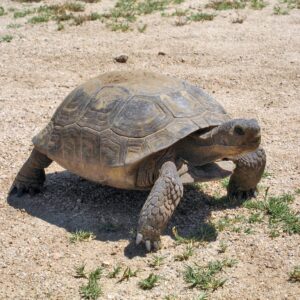USFWS Proposes to Streamline Desert Tortoise Incidental Take
July 25, 2023

On 17 July 2023, the U.S. Fish and Wildlife Service (USFWS) issued a Notice of Intent to prepare an Environmental Impact Statement (EIS) for a General Conservation Plan (GCP) for the federally threatened Mojave desert tortoise in California.
The GCP would streamline the issuance of Endangered Species Act (ESA) Section 10 Incidental Take Permits (ITPs) by eliminating the need for individual Habitat Conservation Plans (HCPs) and National Environmental Policy Act (NEPA) review of each ITP application, a process that can take up to two years. Instead, under the GCP, USFWS would issue ITPs for applications meeting standardized issuance criteria provided for in the GCP. USFWS is proposing a GCP of 10 years, with an option to renew if the plan is successful.
Covered activities would include commercial, agricultural, residential, industrial, and
infrastructure development, as well as operations and maintenance of existing facilities. The “permit area” where ITPs deriving from the GCP would be available is proposed to include non-federal lands outside of conservation areas in southern Inyo County, eastern Kern County, northern Los Angeles County, the desert portion of San Bernardino County, Eastern Riverside County, and portions of Imperial County.
“Mitigation areas” would include “desert tortoise conservation areas,” which the recovery plan for the desert tortoise describes as Bureau of Land Management conservation lands (such as, California Desert National Conservation Lands and areas of critical environmental concern) and other conservation areas or easements managed for desert tortoise. Mitigation options under the GCP would likely include land acquisition, restoration and enhancement of existing habitat, purchase of mitigation bank credits, “other actions needed to protect and conserve desert tortoises,” or a combination of these.
The notice states that action alternatives analyzed in the EIS will likely include variations in the duration of the GCP, the size and locations of permit and mitigation areas, potential translocation areas, and the types of effectiveness monitoring permitted.
Implications
Projects that have a federal nexus – such as projects on federal lands – already benefit from a relatively streamlined, roughly six-month desert tortoise incidental take authorization process through Section 7 of the ESA. By contrast, projects lacking a federal nexus have had to undergo an up to two-year HCP and NEPA process to obtain desert tortoise incidental take authorization under Section 10 of the ESA. With the implementation of standardized conservation measures that obviate the need for individualized HCPs and NEPA reviews, the proposed GCP’s Section 10 permitting process should become faster, less costly, and easier for permittees to navigate, thereby making it easier to obtain ESA desert tortoise incidental take authorization on private lands concurrently with state and local permitting requirements.
The BLM will hold three public scoping meetings. An in-person meeting will be held in Victorville, California on August 10, 2023 and virtual meetings will be held on July 25 and July 27, 2023. BLM will accept scoping comments through August 31, 2023.
The notice states that USFWS expects to publish the draft EIS and GCP in summer 2023 and final documents in late 2023, although we assume these are more likely to happen in summer and winter of 2024, respectively. Additional public comment opportunities will be available after publication of the draft EIS and GCP.
Bell Kearns specializes in advising on the review and entitlement of large-scale renewable energy projects. If you have any questions regarding this article, please feel free to contact us at +1.415.230.0599 or info@bell-kearns.com.

